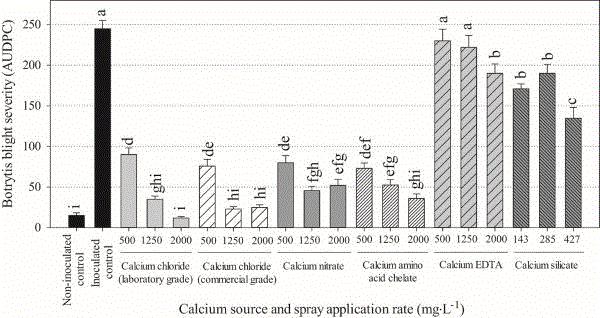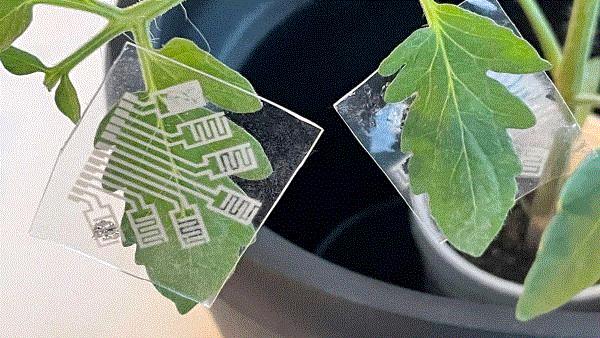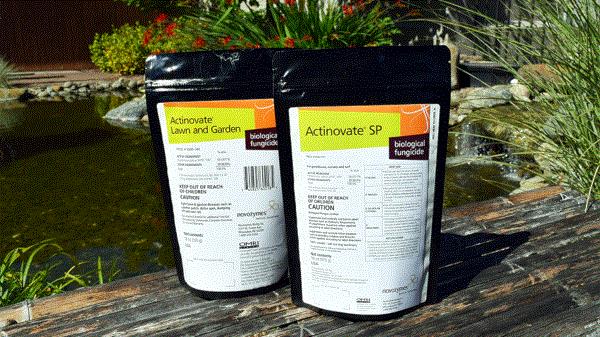Calcium & Botrytis on Petunias
This is going to be like a history lesson: Some of y’all probably remember me talking about preventing Botrytis infection with a calcium spray in one of my earliest newsletters. Calcium sprays are a viable tool in Botrytis management on several crops, including rose and poinsettia. The efficacy of calcium sprays typically increases as calcium concentration increases, but it’s not entirely clear if very high concentration (such as above 1,000 ppm) can aid in Botrytis management and not cause phytotoxicity on flowers. The source of calcium also influences efficacy.
Katherine Bennett, Guido Schnabel and Jim Faust of Clemson University conducted two experiments to find the answers to some of the above questions. (Katie is now with Metrolina.) The first experiment looked at whether calcium spray causes phytotoxicity on petunia flowers (Dreams Red) and the second experiment looked at the efficacy of calcium sprays in preventing Botrytis infection.
They tested six calcium sources—laboratory-grade calcium chloride, commercial-grade calcium chloride, calcium nitrate, calcium amino acid chelate, calcium ethylenediaminetetraacetic acid chelate, and calcium silicate. Each source was tested at three concentrations of calcium, with the first five sources at 500, 1,250 and 2,000 ppm, and calcium silicate at 143, 285 and 427 ppm. The team has published their paper in the April issue of the journal HortTechnology. Click HERE to access the paper.
In the first experiment, 0- (unopened), 1-, 3-, 5- and 7-day-old petunia flowers (still attached to plants, but tagged for identification) were sprayed with water (untreated control) or one of the treatments (one calcium source at one concentration). Phytotoxicity was visually evaluated on a 1 to 5 scale, with 1 = 0% damaged and 5 = 76% to 100% damaged.
In the second experiment, flowers were treated with the same treatments as in the first experiment. The flowers were collected 24 hours after treatment, kept vigorous in vials and then sprayed with Botrytis inoculum. Botrytis infection severity on untreated + inoculated, untreated + uninoculated, and treated plants was rated on a scale of 1 to 9 (1 = 0% and 9 = 100% infection) every 12 hours for 72 hours.
So what did Katie and her team find?

Botrytis blight severity of petunia (Petunia ×hybrida) flowers treated with water (control) and different sources and rates of calcium. Botrytis blight severity is expressed as the sum of the area under the disease progression curve (AUDPC). EDTA = ethylenediaminetetraacetic acid. (Source: Bennett et al. 2023, HortTechnology.)
Calcium chloride, whether it’s commercial or laboratory grade, didn’t cause damage to petunia flowers at 500 and 1,250 ppm. Calcium nitrate caused very little damage at 500 ppm. Other calcium sources, particularly calcium ethylenediaminetetraacetic acid chelate, caused considerable damage (around 2 on a scale of 5). Phytotoxicity damage was higher on opened flowers than on unopened flowers in all treatments. The results suggest that a calcium spray at high concentration is best done before flowers open. My take is you should go with a lower concentration if applied to opened flowers.
When applied at 0 to 1,250 ppm, Botrytis infection was reduced by 85% by calcium chloride (both commercial and laboratory grade), 79% by calcium nitrate, and 76% by calcium amino acid when compared to the untreated, inoculated control. Calcium ethylenediaminetetraacetic acid chelate and calcium silicate didn’t appear to be particularly effective.
Calcium chloride emerged as the clear winner in this experiment by being the most effective product against Botrytis and caused no damage to petunia flowers at 500 and 1,250 ppm. Calcium chloride is cheap, and easy to buy and apply. Calcium chloride spray can be a good option to incorporate into a Botrytis management program, especially where the risk of fungicide resistance development is high.
Click HERE to read the paper.

Early Problem Detection With a Patch?
If we plant problem diagnosticians are granted a wish, I think many of us would want our subjects to speak for themselves. It would have been so much easier if a plant can talk and tell us if it’s thirsty or sick and what ails them. Here's the good news: Researchers at North Carolina State University think their invention has gotten us closer to having plants tell us what’s wrong.
These researchers have developed an electronic patch that can tell if a plant is attacked by pathogens or stressed. In their experiment, the researchers were able to detect tomato spotted wilt virus infection in tomato plants one week before growers could detect the viral disease based on the expression of visible symptoms. The electronic patch could also detect infection by early blight and late blight, and alert the researchers of poor growing conditions, such as overwatering, drought, salinity stress and a lack of sunlight.
This detection patch is based on the idea that, when stressed or attacked by diseases or pests, plants emit volatile organic compounds. What’s even more interesting is that different stressors, pathogens or pests elicit the emission of different compounds. The electronic patch, which is only a little over 1-in. long, has a network of electrodes made of tiny silver wires. Each electrode detects specific volatile organic compounds and gives off an alert about the related problem.
The patch can be attached to the underside of leaves, where it can detect compounds emitted from the stomata during gas exchange. Early detection of a problem is possible because plants emit volatile organic compounds before they show symptoms of stress or infection. Different combinations of electrodes enable patches that are designed to detect different sets of plant problems.

This invention can be transformative to our industry because if the patches can be improved and a detection device that incorporates these patches can be developed, we may be able to automate early plant problem detection. Think about how much easier problem detection can be if a network of these devices can be mounted on different parts of a greenhouse or carried by scouts.
But we are some ways away from that application. The researchers have two issues to resolve before commercialization can be considered. First, a wireless patch should be developed, and second, the technology must be validated in the field.
There are certainly more work that needs to be done before an early detection device can be developed. I, for one, am looking forward to the day when we can detect problems early with either spectrometry (color or infrared) or volatile compounds.
Read more about the new electronic patch for problem detection by clicking HERE.

Actinovate Now Has a Longer Shelf Life
You're probably familiar with the biofungicide Actinovate. This biofungicide contains the beneficial soil bacterium Streptomyces lydicus strain WYEC108. This product is used against fungal diseases, such as damping off, root rot, Botrytis, downy mildew, powdery mildew and brown patch (in turf). Currently, there are three Actinovate branded products—Actinovate SP (for professional use in greenhouse, nursery, landscape and other sites), Actinovate AG (for many crops), and Actinovate Lawn & Garden (for home garden and turf).

Mycorrhizal Applications has announced that effective April 1, 2023, the Actinovate brand of products will be distributed with a two-year shelf life, which doubles the previous shelf life. Actinovate still requires no refrigeration, special handling or complicated storage guidelines.
Additionally, Mycorrhizal Applications is bringing back the 2-oz. packaging for Actinovate Lawn & Garden by popular demand. Actinovate Lawn & Garden is now available in 2-oz. and 18-oz. packing. The smaller packaging is more suitable for retail settings.
Click HERE for more information on Actinovate.

Thrips parvispinus Webinar
I’ve been talking about a new invasive thrip species, Thrips parvispinus, that’s wreaking havoc in central and southern Florida.The Horticultural Research Institute (HRI) will host a webinar on this thrips on Wednesday, May 10, from 1:00 to 2:00 p.m. Eastern. The webinar is supported by HRI, AmericanHort, the Canadian Nursery & Landscape Association, and the American Floral Endowment. Click HERE to register for this free webinar.
The webinar will be presented by Lance Osborne of the University of Florida, Sara Jandricic of OMAFRA (Ontario Ministry of Agriculture, Food and Rural Affairs) and Cristi Palmer of the IR-4 Environmental Horticulture Program. Lance will provide some useful tips on detecting and diagnosing infestation by this thrips species. He'll also talk about how folks in Florida are working on combating this problem. Sarah will talk about how to monitor this thrips and Cristi will provide information on how to manage thrips (in general).
I've heard of this thrips species spreading outside of Florida. We need to get ready for it. I’m attending to learn more about this species and prepare myself, so I hope to see y’all there. Again, click HERE to register for the webinar.





See y’all later!

JC Chong
Technical Development Manager at SePRO
Adjunct Professor at Clemson University
This e-mail received by 27,847 subscribers like you!
If you're interested in advertising on PestTalks contact Kim Brown ASAP!